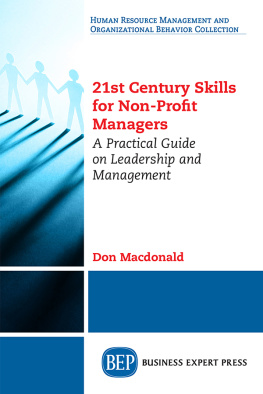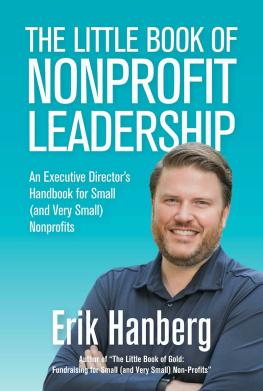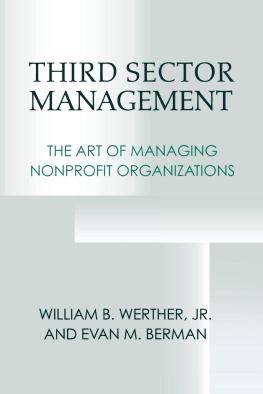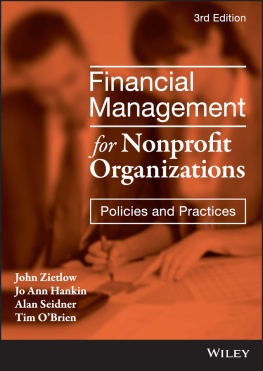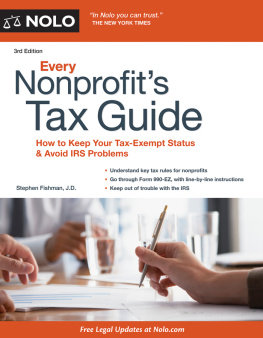
21st Century Skills for Non-Profit Managers
21st Century Skills for Non-Profit Managers
A Practical Guide on Leadership and Management
Don Macdonald

21st Century Skills for Non-Profit Managers: A Practical Guide on Leadership and Management
Copyright Business Expert Press, LLC, 2018.
All rights reserved. No part of this publication may be reproduced, stored in a retrieval system, or transmitted in any form or by any meanselectronic, mechanical, photocopy, recording, or any other except for brief quotations, not to exceed 400 words, without the prior permission of the publisher.
First published in 2018 by
Business Expert Press, LLC
222 East 46th Street, New York, NY 10017
www.businessexpertpress.com
ISBN-13: 978-1-94709-818-3 (paperback)
ISBN-13: 978-1-94709-819-0 (e-book)
Business Expert Press Human Resource Management and Organizational Behavior Collection
Collection ISSN: 1946-5637 (print)
Collection ISSN: 1946-5645 (electronic)
Cover and interior design by Exeter Premedia Services Private Ltd., Chennai, India
First edition: 2018
10 9 8 7 6 5 4 3 2 1
Printed in the United States of America.
This book is dedicated to my children, Lisa and Daniel, and grandchildren,
Stanley and Margot, who are the future. Any royalties go to two UK
charities, Clore Social Leadership and London Football Journeys.
Abstract
Over the last 30 years nonprofit organizations have grown massively in capacity, scope, and authority right across the world. There is a growing demand for services so there are numerous opportunities for nonprofits to respond innovatively and sustainably.
If you are an experienced nonprofit manager, you will know the role is sometimes frustrating but always exhilarating, involving work with people, guiding their ideas and energy and empowering them. Severe funding cuts since the recession make this even more testing, but new prospects are also opening up.
If you are new to the management role or the sector, you need a practical book describing good practice to guide you through the issues and problems. If you manage a small nonprofit, you have to multitask, manage your time and prioritize different tasks. If you have taken on extra responsibilities, you need new skills and knowledge such as how to generate funding.
This book covers all essential aspects (staffing, communications, charity governance, donations, corporate social responsibility, crowdfunding). It contains useful case studies, resources and links, but avoids jargon and intellectualizing. Topics include how to prepare a successful business plan, empower staff and clients, write a successful fundraising application to a trust, or prepare and submit a tender to the U.S. state governments or the UK National Health Service. There is something of use for everyone.
Don has used his experience as a nonprofit manager, volunteer, staffer, fundraiser, trustee and consultant, along with his time overseeing community project funding; so as a gamekeeper turned poacher. This makes the book relevant, topical, and helpful.
Keywords
business ethics, charity donation, charity, competitive tendering, corporate social responsibility, crowdfunding, development, diversity, education, empowerment, evaluation, fundraising, general and human resource management, grant making, green environment, health, investment, leadership, management, NHS, nonprofit organizations, philanthropy, policy, project management, public, social enterprise, social, sustainability, sustainable
Contents
Don Macdonald
Don Macdonald
Don Macdonald
Don Macdonald
Don Macdonald
Don Macdonald
Don Macdonald
Don Macdonald and Charles Oham
Don Macdonald
Don Macdonald and Sue Causton
Don Macdonald
In the last decades, the activity and influence of nonprofit organizations in almost every country in the world have grown exponentially as John Casey has written. In the United States, with a population of 318 million, there are over 1.5 million registered nonprofit organizations including 1,097,689 public charities, with nonprofit employment representing 10.1 percent of total employment in the United States in 2010. In the United Kingdom, with a population of 64 million (2013), around 166,000 charities are registered with the Charity Commission (2016), with the social sector bigger than the motor industry. I concentrate on these two countries for two reasons; the United States has the biggest and most influential nonprofit sector, while I developed my skills and expertise in the United Kingdom (though also working in Asia and Europe). The United States and United Kingdom also share a wide range of nonprofit organizations, cultural attributes and management expertise.
Managing nonprofit organizations is always exhilarating and sometimes frustrating, as it involves working with people at the same time as guiding their ideas and energy while empowering them. However severe funding cuts since the recession makes this even more testing. Leadership and management skills therefore become more important, yet more demanding. Hence the need for a practical book directed at managers, who may be new to the sector or taking on additional responsibilities, thus needing further skills. I have tried to avoid jargons. Readers will have a wide range of previous experience and knowledge; thus the information and concepts may seem too simplistic for some, but irrelevant for others; hopefully there is something of use for everyone, even though people will have differing points of view from me.
I cover all essential aspects, with useful resources and links. I have mainly used my experience as a manager in the nonprofit sector, but also my time as a volunteer, staffer, fundraiser, trustee, and consultant, and even my time in two local authorities, overseeing community project funding; so as a gamekeeper turned poacher.
Don Macdonald
July 17, 2017
)
Shaks Ghosh from the UK Clore Social Leadership Charity encouraged me to write this book and kept this up over the last eighteen months of its gestation. In two chapters, I needed additional expertise, so Charles Oham (Service Planning, Monitoring, Evaluating and Improving a Not for Profit Organization) and Sue Causton (Equal Opportunity, Diversity and Service User Involvement) have cowritten two chapters while Chris Durkin and Kemal Ahson helped with sections. Charles-Antoine Arnaud and Laurel Dutcher both read the whole book, making useful suggestions, while Judith Edwards, Linbert Spencer, Daniel Dumoulin, and David Tyler all checked different chapters. As ever, my wife Kate has been long-suffering and supportive; as an experienced public sector manager herself, she contributed feedback and ideas.
Don Macdonald
Today, nonprofit organizations in the United States control upward of $1.5 trillion in assets and are increasingly relied upon to help address societys ills according to a McKinsey report. Nonprofits operate in an ever-changing world with increasing pressures, hence the need for relevant skills and knowledge for new managers and leaders, which this book attempts to provide.
Definitions and Numbers
Nonprofit organizations are described in different ways, including social organizations, Community and Voluntary Organizations (CVOs), Non-Governmental Organizations (NGOs), and Third Sector Organizations. The sector itself is very varied, even if I ignore all those nonprofit organizations, which are just informal associations and should not require management. I concentrate on those organizations that have been formally constituted in some way or other, such as registered charities and nonprofit companies.
Next page
